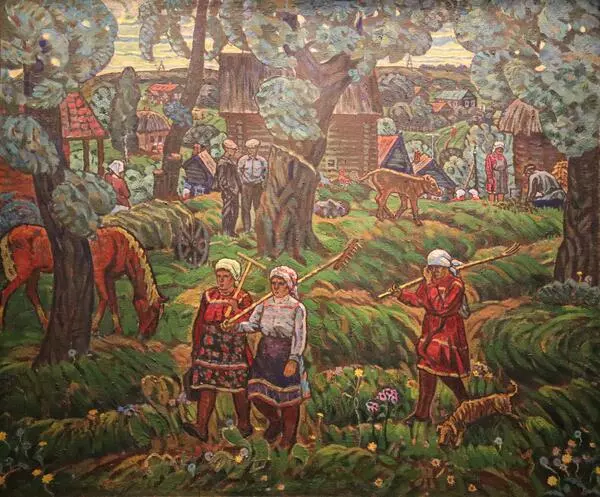The cozy world of the Mordovian village is embodied in the works of Viktor Ivanovich Petryashov, People’s Artist of the Republic of Mordovia.
Viktor Ivanovich Petryashov, painter, graphic artist, teacher, member of the Union of Artists of the USSR, graduated from the Cheboksary Art School in 1964. The artist devoted half a century to bringing up a new generation of artists — that is how long he worked at the Children’s Art School No. 1. Many of his students later became well-known artists, among them Hafiz Bikbaev and Anatoly Kiyaikin. Just a year after finishing art school, Victor Petryashov began to actively participate in exhibitions of various levels. His works are housed in various state collections in Russian cities and private collections, and his work is recognized in the Republic of Mordovia and beyond.
The artist’s works have their own distinctive themes and cheerful atmosphere, their figurative approach and decorative style as well as their lush color palette. His works depict different aspects of contemporary life in thematic canvases, landscapes, still lifes, and subjects of memories, past and present, sports, and urban life. Petryashov’s main themes are related to his homeland. They are the artist’s trademark, they contain the mission of his work: to reveal the beauty of Mordovia. Viktor Ivanovich was one of the most dedicated followers of the traditions of depicting folk life, laid down in the art of Mordovia by Fedot Sychkov. His optimistic worldview, the ability to see harmony in the everyday life of the countryside, the small motherland as the center of love and memories — this is what distinguishes Petryashov’s painting.
The painting “Summer” (1971) belongs to the early period of Petryashov’s work. It is traditionally devoted to rural life, but the artist manages to find a new sounding of a favorite theme. The left part of the canvas reflects the right one like in a mirror. The center of the composition is a vertical line of a birch tree and a group of Moksha women wearing national costumes of the first half of the 20th century. Victor Petryashov shows the scene as if from above and a bit from afar. These techniques create the impression of a dome, fencing off the small, cozy world of the Mordovian village from everything extraneous. It is a world in the artist’s heart, where everything is calm and harmonious. Bright color accents enliven the green of the canvas, emphasizing its optimistic tone.
Viktor Ivanovich Petryashov, painter, graphic artist, teacher, member of the Union of Artists of the USSR, graduated from the Cheboksary Art School in 1964. The artist devoted half a century to bringing up a new generation of artists — that is how long he worked at the Children’s Art School No. 1. Many of his students later became well-known artists, among them Hafiz Bikbaev and Anatoly Kiyaikin. Just a year after finishing art school, Victor Petryashov began to actively participate in exhibitions of various levels. His works are housed in various state collections in Russian cities and private collections, and his work is recognized in the Republic of Mordovia and beyond.
The artist’s works have their own distinctive themes and cheerful atmosphere, their figurative approach and decorative style as well as their lush color palette. His works depict different aspects of contemporary life in thematic canvases, landscapes, still lifes, and subjects of memories, past and present, sports, and urban life. Petryashov’s main themes are related to his homeland. They are the artist’s trademark, they contain the mission of his work: to reveal the beauty of Mordovia. Viktor Ivanovich was one of the most dedicated followers of the traditions of depicting folk life, laid down in the art of Mordovia by Fedot Sychkov. His optimistic worldview, the ability to see harmony in the everyday life of the countryside, the small motherland as the center of love and memories — this is what distinguishes Petryashov’s painting.
The painting “Summer” (1971) belongs to the early period of Petryashov’s work. It is traditionally devoted to rural life, but the artist manages to find a new sounding of a favorite theme. The left part of the canvas reflects the right one like in a mirror. The center of the composition is a vertical line of a birch tree and a group of Moksha women wearing national costumes of the first half of the 20th century. Victor Petryashov shows the scene as if from above and a bit from afar. These techniques create the impression of a dome, fencing off the small, cozy world of the Mordovian village from everything extraneous. It is a world in the artist’s heart, where everything is calm and harmonious. Bright color accents enliven the green of the canvas, emphasizing its optimistic tone.




